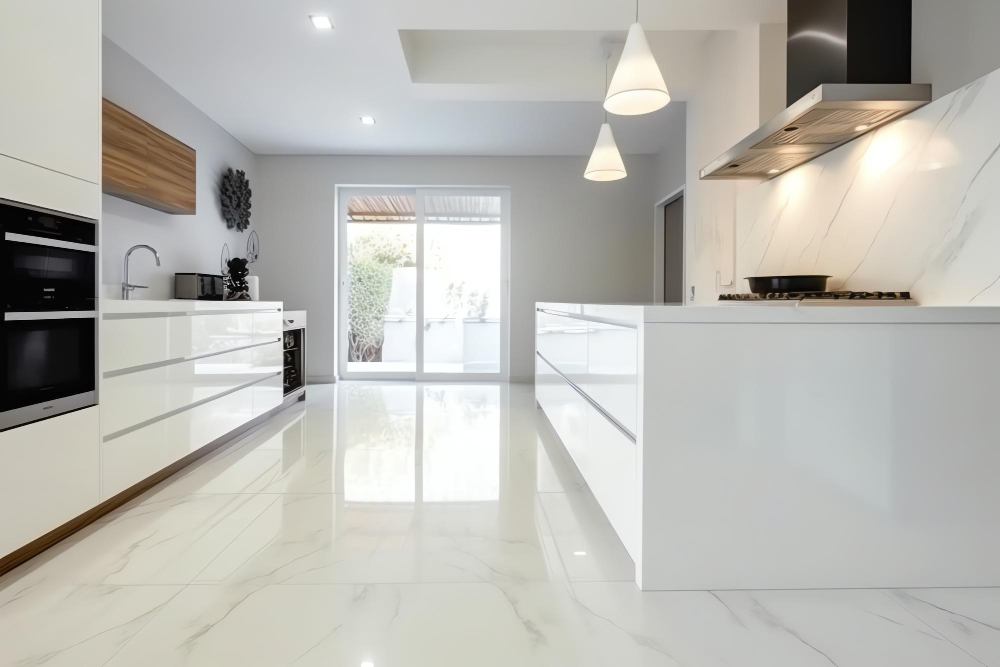Marble Mastery: Tips for Incorporating Marble Tiles into Your Home Renovation Projects

Are you ready to elevate your home renovation game with a touch of timeless elegance? Look no further than marble tiles! Renowned for its luxurious appeal and versatility, marble has become the go-to choice for homeowners seeking a sophisticated upgrade. Our expert tips on how to expertly incorporate marble into your next home renovation project will help you achieve your renovation goals, whether they are to update your bathroom or kitchen or to create a visually striking focal point in your living area. As we reveal the techniques for transforming common areas into extraordinary works of art—all with the captivating appeal of marble—get ready to be inspired!
Introduction:
Marble has been a symbol of luxury and elegance for centuries. It is a natural stone that has been used in construction and decoration since ancient times. With its timeless beauty, durability, and versatility, marble has become a popular choice for home renovation projects.
Marble tiles are one of the most sought-after materials in interior design, and it’s not hard to see why. These marble tiles are available in a range of hues and patterns that can enhance any area, from the elegant black Marquina marble to the timeless white Carrara marble.
We’ll look at the reasons marble tiles are essential for home remodeling projects in this blog post. We’ll talk about their special qualities, and advantages, and how to include them in your remodeling ideas.
Timeless Beauty:
One of the main reasons why marble tiles are so desirable is because of their timeless beauty. The veins and patterns found in natural marble create a unique look that cannot be replicated by any other material. Each tile is one-of-a-kind, making them truly special.
Marble also comes in a variety of colors such as white, gray, black, pink, green, and more. This allows for endless possibilities when it comes to incorporating it into your home design. Whether you want to create a classic or modern look, there is a type of marble tile that will complement your vision perfectly.
Understanding the Different Types of Marble Tiles
Marble tiles are a popular choice for homeowners looking to add elegance and sophistication to their home renovation projects. Known for its timeless beauty and durability, marble has been used in construction and design for centuries. With its unique veining patterns, diverse color options, and natural variations, marble adds a touch of luxury to any space.
It’s crucial to comprehend the various kinds of marble tiles that are out there before using them in your home remodeling project. Every variety has unique qualities and attributes that make it appropriate for particular rooms in the house. To assist you in choosing the best marble tile for your project, we will go over the different varieties in this section.
-
Carrara Marble Tiles
Carrara marble is perhaps the most well-known type of marble and is often associated with luxury and grandeur. It is quarried from the Carrara region in Italy and features a white or light gray background with subtle gray veining. This classic look makes it a versatile option that can be used in almost any room in your home.
-
Calacatta Marble Tiles
Similar to Carrara marble, Calacatta marble is also quarried from Italy but is known for its bolder and more dramatic veining patterns. The white or creamy background with striking gold or grey veins creates a stunning contrast that adds drama to any space.
Pros and Cons of Each Type
When it comes to incorporating marble tiles into your home renovation projects, there are a few different types of marble to choose from. Each type has its unique characteristics and benefits, but also some potential drawbacks that should be considered before making a decision. In this section, we will discuss the pros and cons of each type of marble so you can make an informed decision for your home renovation.
-
Carrara Marble
Carrara marble is one of the most popular choices for homeowners due to its classic white color with grey veining. It is quarried in Italy and has been used in buildings and sculptures for centuries. Some pros and cons of using Carrara marble in your home renovation are:
Pros:
– Timeless aesthetic: Carrara marble has been a staple in interior design for centuries and is still popular today.
– Versatility: This type of marble can be used in various areas of the house such as countertops, backsplashes, flooring, and even in bathrooms.
– Cost-effective: Compared to other types of marble, Carrara is relatively affordable.
– Easy maintenance: With proper sealing, Carrara marble is resistant to stains and scratches.
Cons:
– Porous nature: As with all types of natural stone, Carrara marble is porous which means it can absorb liquids if not sealed properly.
– Prone to etching: Due to its calcium carbonate composition, acidic substances like lemon juice or vinegar can cause etching on the surface if left for too long.
Trending Marble Tile Designs and Patterns for Different Rooms
When it comes to adding elegance and luxury to your home, marble tiles are a top choice for many homeowners. They can improve any room in your house’s aesthetic thanks to their timeless beauty and toughness. There is a large selection of popular marble tile patterns and designs to pick from when remodeling your living room, kitchen, or bathroom.
-
Herringbone Pattern
The herringbone pattern has been gaining popularity in recent years for its modern and eye-catching look. This pattern involves laying rectangular tiles at a 45-degree angle to create a zig-zag effect. It adds visual interest and depth to any space, making it perfect for an accent wall or backsplash in the kitchen.
-
Basketweave Pattern
Similar to the herringbone pattern, the basketweave pattern also creates a unique visual appeal through its interwoven design. It is created by arranging rectangular marble tiles into squares with smaller square tiles placed inside them. This classic yet chic pattern is commonly used in bathrooms but can also add charm to entryways or laundry rooms.
-
Chevron Pattern
The chevron pattern is a great option for people who prefer a more dramatic style. Wherever it is installed, this design will stand out thanks to its V-shaped rows of rectangular tiles that meet at sharp angles. In larger spaces like living rooms or dining rooms, the chevron pattern looks great as an accent wall or on floors.
Tips for Choosing the Right Marble Tile for Your Space
When it comes to incorporating marble tiles into your home renovation projects, choosing the right type of marble is crucial. With so many options available, it can be overwhelming to decide which one will work best for your space. To help you make an informed decision, here are some tips for choosing the right marble tile for your space:
- Consider the style and design of your space: Marble tiles are available in an array of hues and designs, each possessing distinct qualities. Before choosing a marble tile, take into account the general design and style of your area. Do you want to appear refined and classic? Then a marble that is white or grey and has delicate veining might be the best option. Looking for something more dramatic? Opt for black or dark-colored marble with bold veins.
- Determine where the tile will be installed: Another important factor to consider is where the tile will be installed in your home. Different areas have different levels of foot traffic and exposure to moisture and stains, which can affect the durability and maintenance requirements of the marble tile you choose.
For high-traffic areas like kitchens or entryways, opt for a harder and more durable type of marble such as Carrara or Calacatta. Areas that are prone to moisture such as bathrooms or outdoor patios require a less porous option like Crema Marfil or Botticino Classico.
Factors to Consider (Budget, Maintenance, Style)
When it comes to incorporating marble tiles into your home renovation projects, there are several factors that you need to consider. Although marble is an opulent and sophisticated material, using it in your home needs careful thought and preparation. Budget, upkeep, and style are the three key considerations for marble tile installation in home renovations that will be covered in this section.
-
Budget:
The first factor to consider when incorporating marble tiles into your renovation project is the budget. Marble is a premium material and can be quite expensive compared to other types of tiles such as ceramic or porcelain. It is essential to determine how much you are willing to spend on the marble tiles for your project before making any decisions.
Instead of covering large areas, think about using marble as an accent piece to stay within your budget. Smaller marble pieces can be used as borders, or in one section of the room, you can use floor-to-ceiling marble tiles to create a statement wall. Using porcelain or ceramic tiles with a marble appearance is another economical choice; these materials have the same visual appeal but cost less money.
-
Maintenance:
Marble may be a stunning addition to any space, but it also requires regular maintenance and care to maintain its beauty. As a natural stone, it is more porous than other tile materials and can absorb liquids if not sealed correctly. Therefore, proper sealing of marble tiles during installation is vital.
Preparing and Installing Marble Tiles: Step-by-Step Guide
Marble tiles are a luxurious and elegant addition to any home renovation project. Their natural beauty and timeless appeal make them a popular choice for various surfaces such as floors, walls, countertops, and backsplashes. However, installing marble tiles can be a daunting task for beginners. To help you achieve a flawless installation, here is a detailed step-by-step guide on preparing and installing marble tiles.
Step 1: Measure and Plan the Layout
It is essential to precisely measure the space where the marble tiles will be installed before beginning the installation process. This step will assist you in estimating the number of tiles you’ll need and any modifications to make them fit the space precisely. Plan out the tile arrangement as well to make sure all of the patterns and designs you wish to use are correctly aligned.
Step 2: Gather Your Tools
To install marble tiles successfully, you will need some essential tools such as a notched trowel, tile spacers, rubber mallet or hammer, tile saw or nippers (depending on your preference), a leveler, a grout float, and sponge. Having all these tools ready before starting the installation process will save time and ensure smooth progress.
Step 3: Prepare the Surface
The surface where you will be installing your marble tiles must be clean, dry, flat, and free from any debris or dust particles. There are a few essential guidelines that you should follow when implementing marble tiles into your home remodeling projects to create a gorgeous and well-planned aesthetic. These pointers will guarantee that the finished product is fashionable and useful whether you use marble tiles for accent pieces, backsplashes, or flooring.
1. Consider the Different Types of Marble Tiles
Marble comes in a variety of types and colors, each with its unique characteristics. Some popular options include Carrara, Calacatta, Statuario, and Emperador marble. Before making a decision on which type to use in your project, consider factors such as durability, color variation, and veining patterns. Each type has its distinct qualities that can greatly impact the overall look of your space.
2. Think About Placement
Consider the marble tiles’ placement and interaction with other room elements before putting them in for your renovation project. For instance, think about how the marble backsplash in your kitchen or bathroom will contrast or work well with the countertops and cabinets. If you plan to use it as wall cladding or flooring, consider how it will complement other materials like metal or wood accents.
3. Mix and Match with Other Materials
While marble is undoubtedly beautiful on its own, mixing and matching it with other materials can add depth and interest to your design scheme. Consider pairing marble tiles with natural stone like granite or quartz for a luxurious yet earthy feel.

Why Smart Startups Choose Custom AI Business Solutions Today

How to Optimize Business Operations with Vending Machines in Australia

How a portable office for sale can streamline on-site operations and boost productivity

Onsite Tire Change in Ottawa : Safe Fast & Professional Tire Services

Accelerating drug discovery through the DEL-ML-CS approach

Why Smart Startups Choose Custom AI Business Solutions Today

How to Optimize Business Operations with Vending Machines in Australia

How a portable office for sale can streamline on-site operations and boost productivity








